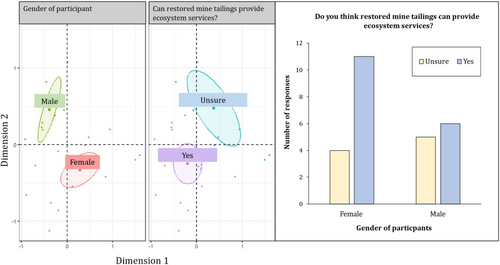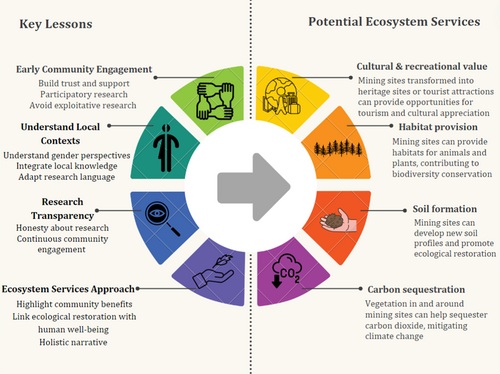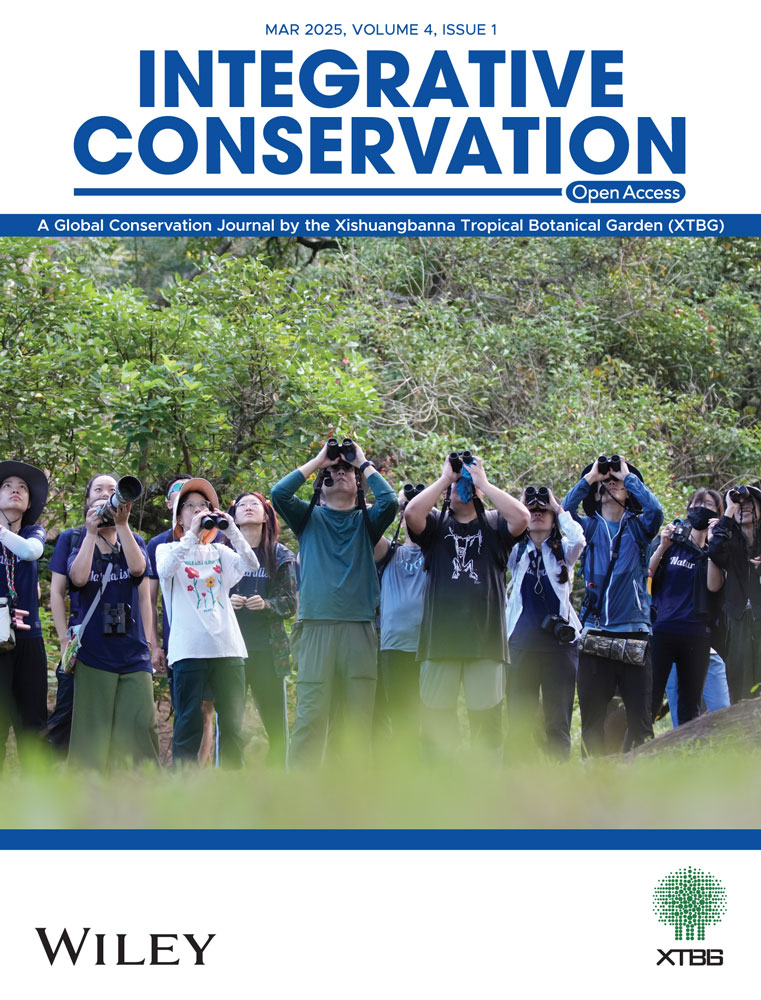Community Engagement and Ecosystem Services for Mine Rehabilitation
社区参与与生态系统服务在矿区修复规划中的应用
Editor-in-Chief: Binbin Li | Handling Editor: Yifu Wang
ABSTRACT
enThe growing global demand for minerals presents economic opportunities for countries such as the Philippines but also raises concerns about the impacts of mineral extraction on local communities and ecosystem services. This study explores an interdisciplinary community engagement process informing mine rehabilitation in the Philippines, framed through an ecosystem services lens. As part of the PROMT (Philippines Remediation of Mine Tailings) project, we conducted an initial participatory workshop at the Padcal Mine site, engaging Indigenous communities to assess local perspectives on ecosystem services and the impacts of mining activities. Through video presentations, a questionnaire, and focus groups, we found that 88% of participants understood the concept of ecosystem services after viewing an introductory video, while 62% believed mining negatively affected ecosystem services. Interestingly, 65% felt that rehabilitated mines could provide future ecosystem services, such as agriculture or ecotourism. Gender differences were evident, with women perceiving more significant mining impacts but being more optimistic about the rehabilitation potential. This underscores the importance of inclusive engagement approaches. The ecosystem services framework effectively bridges ecological knowledge with community priorities and tangible benefits, promoting social acceptance of mine rehabilitation. This interdisciplinary approach, particularly the integration of Indigenous perspectives, remains underused in mining contexts. Our community-based participatory methodology provides guidance for balancing diverse socioeconomic and environmental considerations.
摘要
zh全球矿产需求的增长为菲律宾等国家带来经济机遇, 同时也引发了对社区和生态系统服务影响的担忧。本研究通过生态系统服务的视角, 展示了一个指导矿区复垦的跨学科社区参与过程。作为菲律宾尾矿修复项目 (PROMT project) 的一部分, 我们在帕德卡尔矿区与原住民社区开展了初步的参与式座谈会, 评估当地对生态系统服务和采矿影响的看法。通过视频展示、问卷调查和焦点小组讨论, 我们发现88%的参与者在观看介绍视频后理解了生态系统服务的概念, 62%的参与者认为采矿对生态系统服务产生负面影响。65%的参与者认为经过修复的矿区可以提供未来的生态系统服务, 如农业或生态旅游。研究发现存在性别差异:女性认为采矿影响更大, 但对修复潜力持更积极态度, 这凸显了包容性参与方法的重要性。生态系统服务框架将生态学知识与社区的切实利益联系起来, 促进了社会对修复工作的接受。这种跨学科方法在采矿领域的应用还很有限, 尤其是在纳入原住民视角方面。我们提出的基于社区参与的方法为协调社会经济和环境多重目标提供了新的思路。
简明语言摘要
zh采矿业带来经济效益, 却可能会损害当地社区和自然资源。我们的研究通过直接与菲律宾当地社区对话, 探讨了矿区关闭后土地使用的更好规划方法。我们在帕德卡尔矿场举办了座谈会, 社区成员分享了他们对自然如何支持生活以及采矿如何影响这些益处的看法。通过视频、问卷调查和小组讨论, 我们发现大多数参与者 (88%) 在观看我们提供的教育视频后理解了自然为人类提供的各种益处。虽然许多人 (62%) 认为采矿损害了这些自然惠益, 但约三分之二的人相信经过适当修复的矿区可以重新用于农业或旅游。女性群体认为采矿的影响更为严重, 但对修复工作更有希望。我们关注自然惠益的方法将科学知识与当地社区最关心的问题联系起来, 使他们更有可能支持修复项目。这种方法在采矿项目中使用得不够频繁, 但它提供了一种平衡经济、社会和环境需求的有效方式。
实践者要点
zh
-
通过生态系统服务的视角来规划矿区关闭后的土地利用, 有助于缩小技术修复方法与社区需求之间的差距, 从而提高社会对修复项目的接受度。
-
性别敏感的参与方式至关重要, 突显了确保多元化视角参与矿区关闭后规划的重要性。
-
采用参与式方法早期与当地社区接触, 能够提高对生态系统服务概念的理解, 并有助于将当地知识融入矿区关闭后的策略中。
Summary
enMining brings economic benefits but can also harm local communities and the environment. Our study focused on better planning for land use after mining activities end in areas of the Philippines by engaging directly with local communities. We held a workshop at the Padcal Mine where community members shared their views on how nature supports their lives and how mining affects these benefits. Using videos, surveys and group discussions, we found that most participants (88%) understood the concept of ecosystem services after watching our educational video. While many (62%) felt mining harmed these natural benefits, about two-thirds believed that properly restored mine sites could be repurposed for farming or tourism. Women in the group viewed the impacts of mining as more severe but were more hopeful about the potential for restoration. Our approach, which focuses on the benefits that nature provides, helped link scientific knowledge with local priorities, making communities more likely to support restoration projects. This method is rarely used in mining projects but offers an effective way to balance economic, social and environmental needs.
-
Practitioner Points
- ○
Framing post-mining land use through an ecosystem services lens helps bridge the gap between technical rehabilitation approaches and community priorities, leading to greater social acceptance of restoration projects.
- ○
Gender-sensitive engagement is critical, ensuring diverse perspectives are considered in post-mining planning.
- ○
Early engagement with local communities through participatory methods improves understanding of ecosystem services and facilitates the integration of local knowledge into post-mining strategies.
- ○
1 Introduction
Ecosystem service approaches combine environmental and socioeconomic knowledge to understand how communities value and depend on nature (Kenter et al. 2019). Over recent years, the ecosystem services concept has evolved significantly, moving towards more pluralistic approaches. The Intergovernmental Science-Policy Platform on Biodiversity and Ecosystem Services (IPBES) introduced the idea of “Nature's Contributions to People” (NCP) as a broader framework, encompassing ecosystem services and other approaches to human-nature relationships (Pascual 2017; Díaz et al. 2018). This framework aims to better incorporate diverse worldviews, including those of Indigenous and local communities.
As global mineral demand rises, mineral-rich countries in the Global South are presented with promising economic opportunities. However, mining often involves trade-offs between financial gain and the degradation of ecosystem services. The production of mine tailings (mining waste) has negative impacts on ecosystems and communities worldwide, although these can be minimised through responsible management (Sonter et al. 2018). The PROMT (Philippines Remediation of Mine Tailings) project aims to rehabilitate mine sites using approaches developed through an ecosystem services lens.
- 1.
Assess the effectiveness of using ecosystem services concepts to engage Indigenous communities in discussions about mine rehabilitation.
- 2.
Investigate Indigenous community members' understanding and perceptions of ecosystem services in relation to mining activities.
- 3.
Explore gender differences in perceptions of mining impacts and rehabilitation potential.
- 4.
Identify potential ecosystem services that rehabilitated mine sites could provide, as perceived by local communities.
2 Materials and Methods
2.1 Research Area
On 22 March 2022, we hosted the first community workshop at the Philex Mining Corporation (Padcal Mine Site) in Benguet. Benguet Province is situated in the Cordillera Central Mountain range, with elevations ranging from 120 m to 2930 m. This region is characterised by rugged mountains, rivers, and forests. Agriculture is the predominant land use, with crops such as vegetables and coffee grown on mountain terraces. Philex is one of the largest copper and gold producers in Southeast Asia, and the Padcal mine, established in 1958, covers an area of 95 hectares. The mine site supports a community of 2000 employees from diverse ethnic backgrounds. It is located within the ancestral domains of the Igorot tribes, who receive royalties for the use of their land.
2.2 Stakeholder Mapping
To identify stakeholders, we held meetings between the PROMT team and the Community Development Officer from Philex. The Community Development Officer is an Indigenous person who has a longstanding relationship with local communities. We constructed a stakeholder matrix to categorise stakeholders who are impacted by or have an interest in the project (Figure 1). As this was the first event, we focused on engaging stakeholders in the “Manage Closely” category. All participants at the workshop were from Itogon and Ampucao Indigenous communities, reflecting the complex relationship between mining companies and Indigenous groups.

2.3 Workshop Activities
Activities included video presentations, a questionnaire, focus group discussions and a Q&A session. Experts from the PROMT project contributed through prerecorded videos. The first author provided a prerecorded video that introduced the concept of ecosystem services in accessible language. Following this, participants completed a short questionnaire on ecosystem services (Supporting Information: Appendix S1), designed to assess their understanding of the video content and their perspectives on ecosystem services in the context of mining. We then conducted focus group discussions to gain deeper insights into participants' opinions of the project. Participants wrote their responses on Post-it notes, which were then stuck on a wall.
2.4 Ethics Procedures
All participants gave prior informed consent, with explanations about the workshop provided by local collaborators. The community was engaged in collaboration with a researcher based in the Philippines who has a long-term relationship with the community. Her knowledge of local protocols ensured that the consultation process adhered to local practices, including direct engagement with community elders and recognised community leaders.
2.5 Data Analysis
Local researchers recorded and translated questionnaires and focus group comments into English. The questionnaire data were coded using NVivo qualitative data analysis software (Version 20.6.1) to conduct thematic analysis. Additionally, using the “FactoMineR” package in the statistical programme R, multiple correspondence analysis (MCA) was applied to visualise and identify underlying patterns in the questionnaire data (multidimensional categorical data).
3 Results
3.1 Participant Demographics
There were 26 participants, with a range of occupations, including homemakers, small-scale miners, environmental coordinators, and civil engineers. The group had a well-balanced gender representation (54% female, 42% male and 4% undisclosed), and participants ranged in age from 30 to 65 years old. Half of the participants had attained a bachelor's degree or higher, 23% had completed senior high school, and 19% had completed junior high school or had lower levels of education.
3.2 Ecosystem Services and Gender Perspectives
Despite the detailed video introduction on ecosystem services, only 88% of the participants understood the concept. Participants who agreed with the statement “I know a lot about environmental protection” were more likely to be familiar with ecosystem services (60%, n = 26).
Most participants (62%) thought that mining activities negatively impacted ecosystem services, with a higher percentage of females (80%) agreeing compared to males (55%) (p = 0.2, Fisher's exact test). An open-ended question was asked about which ecosystem services participants thought were impacted. The responses were thematically sorted into provisioning, regulating and cultural services. The primary focus was on provisioning services (50%) and regulating services (38%), with cultural services mentioned briefly by 13% of participants.
When asked “Do you think mine tailings can be restored to provide ecosystem services?”, 65% of participants answered “yes”, while 35% answered “unsure”. The MCA plot (Figure 2) shows a division between male and female participants into two clusters. A higher percentage of females (73%) believed that restored mine tailings could provide ecosystem services compared to 55% of males. Meanwhile, 45% of males were unsure whether restored mine tailings could provide ecosystem services, compared to 27% of females.

3.3 Perceived Ecosystem Services in Rehabilitated Mines
“You can use it for agricultural land or as a tourism spot”.
“It can be restored if it is no longer operational for the company. Convert it to a park or a farm.”
“There is a need to research regarding mine tailings”.
“Because I haven't seen an example exactly in our municipality”.
3.4 Focus Group Discussion on the Ecosystem Services Approach
Most participants applauded the team for seeking more responsible solutions for mine rehabilitation. Many expressed optimism about the potential ecosystem services that reclaimed mine tailings could provide. However, participants emphasised that the project is still in its early stages, and its theories have yet to be proven effective. Some were sceptical about whether the work of PROMT could bring tangible benefits to the community. All participants expressed a desire to remain informed about the progress of the project.
4 Discussion
Our integration of ecosystem services and participatory methods bridges conventional divides between researchers and local communities. Through participatory dialogues, researchers can build trust and identify ecosystem services that align with community needs. This approach should be applied globally to promote socially just mine rehabilitation.
The complex relationship between Indigenous Filipino communities and mining provides critical context. Although colonisation impacted lowland groups in the Philippines, remote Indigenous Filipino communities retained greater cultural distinctness and ownership of ancestral lands than their counterparts in other colonised countries (Chaloping-March 2018). Initial mining acceptance has given way to dissatisfaction over environmental costs and unequal economic benefits (Holden et al. 2011). This situation—where Indigenous communities retain land rights but face development pressures in impoverished but mineral-rich regions—demands context-specific research that is sensitive to power dynamics. Our workshop feedback was positive, with participants expressing appreciation for the new knowledge they gained. We aim to build trust, avoid exploitation and ensure that communities benefit equitably in the long term.
Our focus group raised concerns about the project's potential environmental impacts, including its effects on groundwater integrity and community benefits. The researchers provided detailed responses where possible and acknowledged areas of uncertainty that require further investigation. Such transparency is key to building trust and resolving conflicts surrounding mining research (Moomen and Dewan 2017). We emphasised the importance of inclusive dialogue and knowledge coproduction between experts and communities, striving to create space for diverse perspectives.
Globally, the ecosystem services approach will play an important role in mine closure planning, as many regions will require rehabilitation. A key challenge lies in communicating the concept in locally relevant terms, moving beyond technical jargon. A problem illustrated by the fact that some participants found the term “ecosystem services” confusing. In future activities, using tangible examples can make ecosystem services more comprehensible (Delorme et al. 2021). Understanding local contexts and adapting research language will lead to more successful engagement. Helping communities grasp tangible examples of ecosystem services that will benefit them will make mine rehabilitation relatable.
Our findings align with studies showing that communities understand the environmental trade-offs of mining (Wang 2016), but our participants are more optimistic about restoration potential than other research has indicated (van der Plank et al. 2016). This optimism likely stems from framing ecological rehabilitation in terms of tangible community benefits through the ecosystem services lens, which promotes social acceptance. Communities are more receptive when environmental initiatives directly address local needs, rather than when they are imposed in a top-down manner that is disconnected from lived realities.
More female participants perceived the negative environmental impacts of mining but were also more optimistic about rehabilitation. This aligns with research showing that women tend to perceive greater environmental risk (Subiza-Pérez et al. 2020), which likely influences their stronger belief that mining degrades ecosystem services. However, women's greater empathy and commitment to environmental stewardship likely explain their higher confidence in rehabilitation. This indicates a relational perspective, where nature is viewed as capable of recovery when properly cared for. This view aligns with Chan et al.'s (2016) argument that relational values are central to Indigenous worldviews. Understanding how gender and other sociocultural factors shape environmental perceptions can help inform more inclusive research in mining rehabilitation.
The ecosystem services concept can provide a compelling narrative to engage communities focused on economic benefits. Some participants appreciated the idea that reclaimed mines could provide ecosystem services, indicating potential social acceptance. Local communities often find it difficult to conceptualise future mine closure because of the economic benefits they bring. However, if researchers can help communities envision scenarios in which former mines generate tangible benefits (Figure 3), a pluralistic ecosystem services approach can serve as an effective narrative for environmental stewardship.

By integrating community perspectives into project planning, our research presents a collaborative stewardship model. Traditional mine rehabilitation often relies on a Eurocentric worldview that separates humans and nature, but ecological restoration does not automatically result in societal benefits (Rosa et al. 2020). This approach is unsuitable for Indigenous communities, who have distinct ways of relating to ecosystems. Recent academic discourse has shifted towards more pluralistic approaches to valuing nature, acknowledging the limitations of conventional ecosystem service frameworks in capturing diverse worldviews. These approaches recognise that different communities may value their relationships with nature in ways that do not align with Eurocentric scientific categorisations (Pascual 2017). Recent research has introduced the concept of “relational values” to bridge the gap between instrumental and intrinsic values of nature (Klain et al. 2017). Chan (2016) argue that relational values play an important role in Indigenous worldviews of human-nature relationships. By adapting the ecosystem services framework beyond its Eurocentric origins, we can make this concept locally relevant and inclusive. In the context of mine rehabilitation, these pluralistic approaches can lead to more culturally appropriate and sustainable outcomes. Nevertheless, pluralistic valuation presents challenges in the mining context, where economic imperatives frequently dominate decision-making. Future research should explore how Indigenous valuations of nature can be integrated into mine rehabilitation practices. Our initial findings provide valuable guidance for more inclusive mine rehabilitation in the Philippines and beyond.
Author Contributions
Yuan Pan: conceptualisation, supervision, methodology, writing – original draft, writing – review and editing, funding acquisition. Sarah Duddigan: conceptualisation, formal analysis, visualisation, writing – review and editing. Ma Catriona E. Devanadera: conceptualisation, investigation, methodology, supervision, project administration. Rico Neil M. Quierrez: investigation, project administration, writing – review and editing. Mark Tibbett: conceptualisation, supervision, writing – review and editing, funding acquisition.
Acknowledgments
We thank all individuals who took part in the community workshop event and the wider PROMT project team in the Philippines and the UK. This work was supported by NERC (Natural Environmental Research Council) UK under Grant [NE/W006847/1].
Conflicts of Interest
The authors declare no conflicts of interest.
Open Research
Data Availability Statement
The data that support the findings of this study are available from the corresponding author upon reasonable request.




